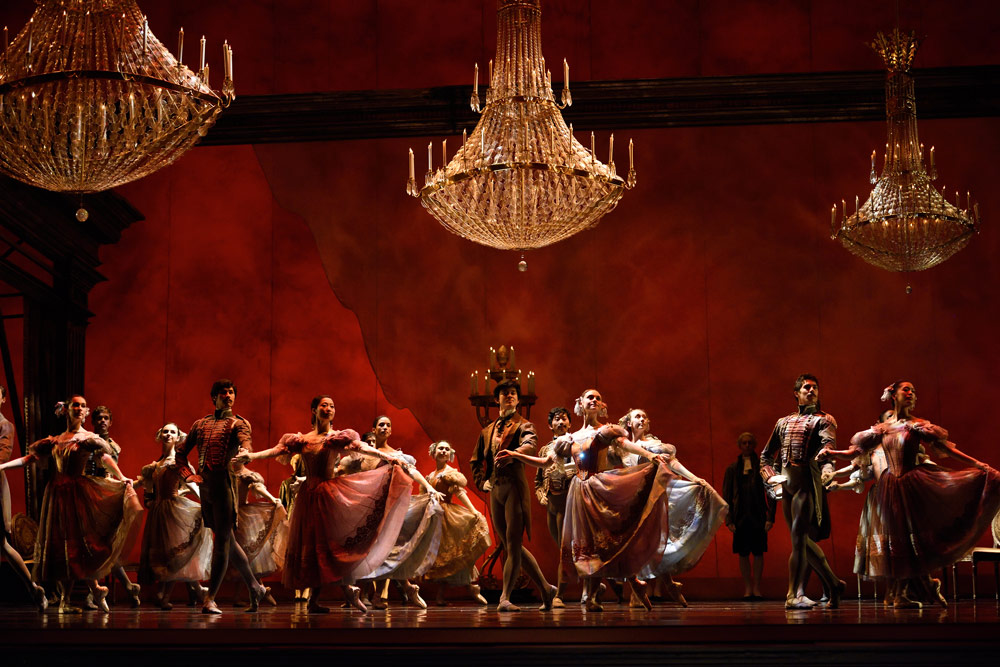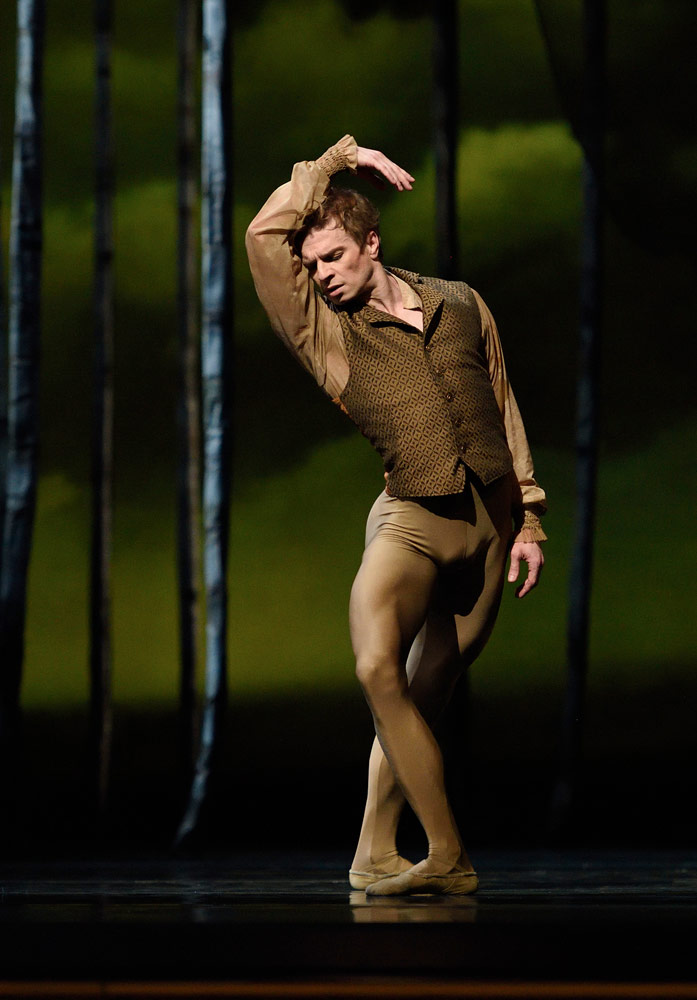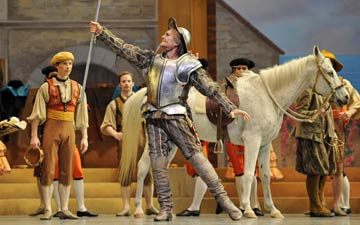
© Erik Tomasson. (Click image for larger version)
San Francisco Ballet
Onegin
★★★★✰
San Francisco, War Memorial Opera House
30 April 2016
www.sfballet.org
The San Francisco Ballet season came to a poetic end with Onegin. Created in 2010 for the National Ballet of Canada, this production of the late John Cranko’s 1965 ballet was a smash here in 2012; it was reprised in 2013 and it’s wonderful to have it back again so soon.
Like the opera Eugene Onegin, the ballet reinterprets Alexander Pushkin’s 1833 tragic verse novel of the same name. Bored St. Petersburg dilettante Onegin arrives in a country town to visit his friend Lensky. Cynical and arrogant, Onegin plays with emotions for sport, and he sets tragedy in motion when he disdainfully toys with the romantic young Tatiana and her elder sister Olga, who is Lensky’s betrothed.
Tchaikovsky wrote the opera and, inadvertently, the score for Cranko’s ballet, which is a jukebox of caprices, impromptus, polonaises and excerpts from “The Seasons,” “Romeo & Juliet” and “Francesca da Rimini,” played sensitively by SFB’s award-winning orchestra. The medley format could be distracting to someone intimately familiar with Tchaikovsky’s oeuvre, but each selection illustrates a feeling rather than a plot point, as does Cranko’s expressionistic choreography.

© Erik Tomasson. (Click image for larger version)
Cranko’s steps come from the classical canon, but they’re pared to a streamlined set of développés, arabesques, pirouettes and châinés, deployed in potently expressive ways. Tatiana’s full-body, fully extended arabesques convey unfulfilled longing; Onegin’s Act I pirouettes are meant to allure, while double turns, halted in between by a fierce stomp of the foot, express fierce anxiety about his impending duel with Lensky.
A rare ballet with an anti-hero as the lead character, Onegin places life’s bitterness at center stage and illustrates the many paths that lead to it: the betrayed innocence of Tatiana, the heedless impulsiveness of Olga, the rigid pride of Lensky, the irredeemable regret of Onegin. As clearly plotted as Onegin is, it is inhabited by these feeling states, dualities that coexist in one mind, rather than by characters per se.
For opening night, SFB cast three of its most seasoned interpreters of this ballet. Maria Kochetkova and Gennadi Nevigin, who danced Tatiana and Lenksy, read Pushkin’s novel growing up and instinctively understand both its soul and the nuance of the original Russian. And never has there been a more alluring, brooding or tormented Onegin than Vitor Luiz, masterfully measured and silently roiling.

© Erik Tomasson. (Click image for larger version)
Kochetkova’s petite frame, expressive eyes and pristine technique beautifully embody Tatiana’s innocence, and when she points Onegin to the door in the final scene, she musters an authority you don’t expect from the dreamy bookworm we met in Act I. She and Luiz have a longstanding and productive partnership, and their mutual trust is evident in the bedroom scenes, both when she dreams of him as a young girl and in the denouement years later. He lifts her over and over, whipping her body around his own, or catching her in a backbend atop his shoulder; she drags him across the floor, then stands, arches her back and falls blindly backwards. Their mutual passion feels real to us and dangerous to them.
Nedvigin danced his swan song as Lensky; after completing Onegin he will retire from SFB to become the artistic director of Atlanta Ballet. Like Kochetkova, he is Bolshoi-trained, and his gifts will be sorely missed: airy jumps with powder-soft landings, effortless turns, the kind of technical mastery that allows a dancer to yoke choreography into the service of the story.
His disintegration from infatuated to insulted to enraged culminates in a pre-duel solo that is subtle and soulful. Alone in the forest, awaiting Onegin’s arrival, Lensky comes to terms with the fate he has set for himself. Nedvigin dances with not-yet-resigned melancholy, holding arabesques an extra second, finishing a pirouette by draping his arms down, head leaned back, chest open in mournful readiness.

© Erik Tomasson. (Click image for larger version)
Soloist Lauren Strongin, in her role debut as Olga, is a vibrant new addition to the company, with a very clean technique and engaging charisma. Her Olga was more flirtatious than tender, courting danger rather than being lured into it. She seemed less self-assured than usual on opening night, but I have to attribute it to opening-night jitters, as she is an experienced and confident performer.
The final poignant turn was Joan Boada’s Gremin. Boada also retires from the principal ranks at the end of this run, and the kind affection he showed Tatiana onstage was likely a blend of Gremin’s love for his wife and the Boada’s fondness for his longtime partner. There was an extra layer of wistfulness in the way she leaned her head on his shoulder, and he kissed her hands.

© Erik Tomasson. (Click image for larger version)
The corps de ballet was festive in the country character dances and the showy parade of partnered sauts de chat, and grand in the ballroom. The women get a bit lost in Santo Loquasto’s heavy-skirted costumes, and nothing can save the young corps men cast as the village grandfathers, hunched with pretend lumbago and squinting with imitation myopia.
At any rate, the dresses’ soft colors, created by layering translucent fabrics and lace, plus a light application of sparkle, suggest a specific time and place receding into the background. Loquasto’s scenic design makes efficient use of a few columns, chandeliers and drapes to conjure the rustic and elegant settings, assisted by James F. Ingalls’ lighting, which shifts in hue, like a mood ring, to express Onegin’s inner world.

















You must be logged in to post a comment.